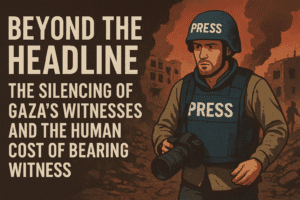Beyond the Headline: The Silencing of Gaza’s Witnesses and the Human Cost of Bearing Witness
The targeted Israeli airstrike killing Al Jazeera journalists Anas al-Sharif, Mohamed Qureiqa, and four colleagues outside Gaza’s Shifa Hospital represents a devastating blow to truth-telling in a conflict already starved of independent witnesses. These reporters were among the last voices documenting daily horrors like bombardment and famine for a world largely barred from Gaza. Their deaths follow a pattern where Israel accuses journalists of militant ties without public evidence, a tactic UN experts warn aims to suppress documentation of potential war crimes.
Beyond the staggering statistic – over 186 journalists killed, making this the deadliest conflict for reporters – lies profound human cost: fathers separated from families, raw on-air grief witnessing starvation, and final messages affirming their commitment to truth. When journalists are silenced, crucial narratives vanish, intimidation grows, and the path to accountability darkens. Protecting these witnesses isn’t peripheral; it’s fundamental to understanding humanity’s darkest hours and achieving justice.

Beyond the Headline: The Silencing of Gaza’s Witnesses and the Human Cost of Bearing Witness
The recent Israeli airstrike that killed Al Jazeera journalists Anas al-Sharif and Mohamed Qureiqa, along with four other journalists and two others sheltering near Gaza City’s Shifa Hospital, isn’t just another tragic statistic. It represents a profound erosion of truth-telling in a conflict where independent eyes are increasingly scarce, and the human cost of documenting war is paid in lives.
More Than Casualties: The Last Voices from Within
International media access to Gaza has been severely restricted throughout the conflict. Al Jazeera, despite facing accusations, blockades, and office raids by Israel, remained one of the few outlets maintaining a significant reporting presence. Journalists like al-Sharif and Qureiqa weren’t just reporters; they were crucial conduits, documenting the daily realities of bombardment, starvation, and displacement endured by Gaza’s civilians. Their deaths, following the killings of other Al Jazeera journalists like Ismail al-Ghoul and Hossam Shabat, leave an ever-shrinking pool of on-the-ground witnesses.
The Weight of Witnessing: Personal Sacrifice in the Line of Duty
The human stories behind the bylines reveal the immense personal toll:
- Anas al-Sharif (28): Separated from his family for months during the war, his reunion during a ceasefire showed children struggling to recognize their father. His reporting focused relentlessly on northern Gaza’s devastation and the ensuing famine. His raw emotion on air, witnessing a woman collapsing from hunger, underscored the visceral impact of his work. His pre-written farewell message spoke of unwavering commitment: “I never hesitated for a single day to convey the truth as it is, without distortion or falsification.”
- Mohamed Qureiqa (33): A Gaza City native, also separated from his wife and two children for extended periods, sharing the same painful reunion experience. He became another silenced voice chronicling life amidst destruction.
The Chilling Context: Accusations and Accountability
Israel swiftly claimed responsibility, a departure from its usual response to journalist deaths, labeling al-Sharif as a “Hamas cell leader” – an accusation both Al Jazeera and al-Sharif had vehemently denied previously as baseless. This pattern of accusing journalists of militant ties without presenting public, credible evidence, followed by lethal force, raises grave concerns. As Sara Qudah (CPJ) stated, it “raises serious questions about its intent and respect for press freedom.”
This incident occurred weeks after a UN expert, Irene Khan, warned that such killings appeared “part of a deliberate strategy of Israel to suppress the truth, obstruct the documentation of international crimes and bury any possibility of future accountability.”
The Bigger Picture: An Unprecedented Assault on Journalism
This tragedy underscores a horrifying reality documented by the Committee to Protect Journalists (at least 186 journalists killed in Gaza) and Brown University’s Watson Institute (calling it “the worst ever conflict for reporters”). Journalists are not collateral damage; they are increasingly the targets. When reporters are killed, the world loses its eyes and ears. Truth becomes fragmented, accountability recedes, and the suffering of civilians risks fading into obscurity.
The Real Loss: What Disappears When the Cameras Go Dark
The targeted killing of journalists like al-Sharif and Qureiqa represents more than individual tragedy. It signifies:
- The Silencing of Crucial Narratives: Who now documents the daily struggle for survival in Gaza’s most devastated areas?
- The Intimidation of Remaining Voices: What journalist can report without fear when accusations precede airstrikes?
- The Erosion of Historical Record: Without independent documentation, the full scope of suffering and potential war crimes becomes harder to establish.
- The Dehumanization of Truth-Tellers: Reducing journalists to alleged combatants strips them of their protected status and endangers all media workers.
The legacy of Anas al-Sharif, Mohamed Qureiqa, and their colleagues isn’t just in the stories they filed, but in the stark void their absence creates. Their deaths are a brutal reminder that in the fog of war, the first casualty is often truth, and those who fight to preserve it pay the highest price. The world loses not just reporters, but witnesses to humanity in its darkest hour. Protecting them isn’t a side issue; it’s fundamental to understanding, justice, and ultimately, peace.
You must be logged in to post a comment.